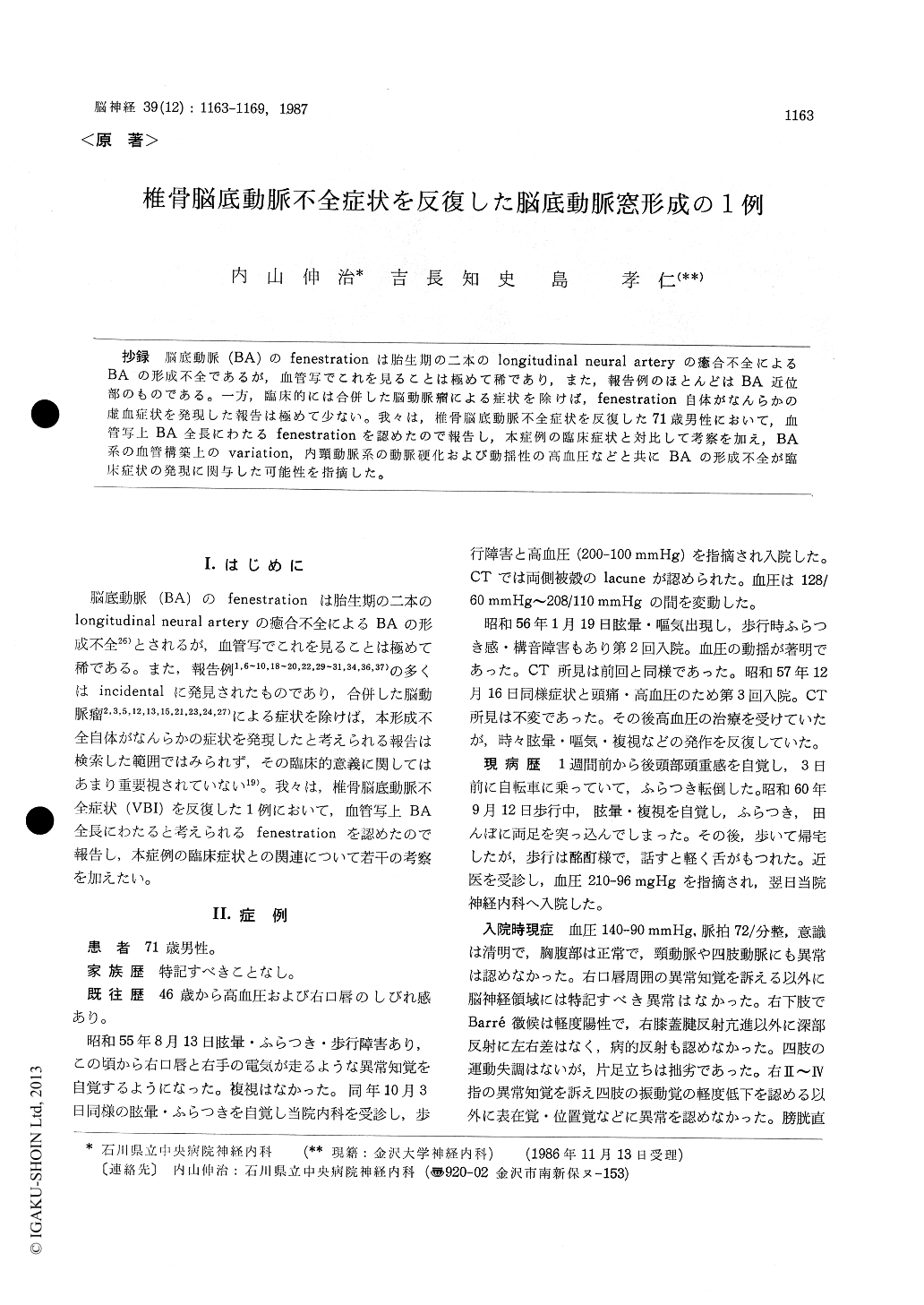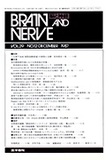Japanese
English
- 有料閲覧
- Abstract 文献概要
- 1ページ目 Look Inside
抄録 脳底動脈(BA)のfenestrationは胎生期の二本のlongitudinal neural arteryの癒合不全によるBAの形成不全であるが,血管写でこれを見ることは極めて稀であり,また,報告例のほとんどはBA近位部のものである。一方,臨床的には合併した脳動脈瘤による症状を除けば,fenestration自体がなんらかの虚血症状を発現した報告は極めて少ない。我々は,椎骨脳底動脈不全症状を反復した71歳男性において,血管写上BA全長にわたるfenestrationを認めたので報告し,本症例の臨床症状と対比して考察を加え,BA系の血管構築上のvariation,内頸動脈系の動脈硬化および動揺性の高血圧などと共にBAの形成不全が臨床症状の発現に関与した可能性を指摘した。
Fenestration of basilar artery is an uncommon vascular anomaly that is usually an incidental product on autopsy or angiography. None of the cases in the literature had clinical symptoms asso-ciated with this anomaly excepts for subarachnoid hemorrhage when accompanied with saccular aneu-rysm.
We report a rare case of the basilar artery fenestration associated with clinical symptoms without any aneurysm.
A 71-years-old male, who had been treated for labile hypertension and had had recurrent attacks of vertigo, nausea, sometimes diplopia or unsteady gait, for 5 years, was referred to our hospital on Sept. 13, 1985. One day prior to admission, he suddenly felt diplopia and vertigo and unsteady gait. His family noticed he was dysarthric.
On admission, he was alert and normotensive. He complained of dysesthesia on the right half of the perioral region and his right fingers. A neurological examination showed a mild weakness and hyperactive deep tendon reflexes on his right leg. His motor coordination was almost normal, but he was unsteady when he stood on one foot with his eyes closed.
Laboratory examinations were normal except for an elevated serum uric acid level. A chest x-ray film showed a sclerotic change of aorta and mild cardiomegaly. Left ventricular hypertrophy was observed on his ECG. His CT scans showed multiple lacunes and mild brain atrophy. On cerebral angiography, his basilar artery (BA) had a fenestration almost in its total length that dividedthe BA, like a duplication, into two components with a smaller diameter than normal. The left vertebral artery (VA) had a more predominant blood supply on the BA than the right VA which became smaller in diameter after branching off the right posterior inferior cerebellar artery (PICA). The left anterior inferior cerebellar artery (AICA) that originated from one of the two components of the BA, supplied also the territory of hypoplastic left PICA. The well-developed right PICA that originated from the lesser right VA, nurlished also the territory of right AICA that was absent onthe right. Arteriosclerosis was not remarkable in his posterior circulation. On the other hand, mild extra- and intracranial stenosis was observed in both internal carotid arteries.
The circulatory handicaps in his basilar arterial system due to the fenestration and variation in blood supply of developmental origin, in addition to his labile hypertension and the stenosis in the anterior circulation, was suggested as one of the pathogenetic factors in the recurrent attacks of VBI in this case.

Copyright © 1987, Igaku-Shoin Ltd. All rights reserved.


